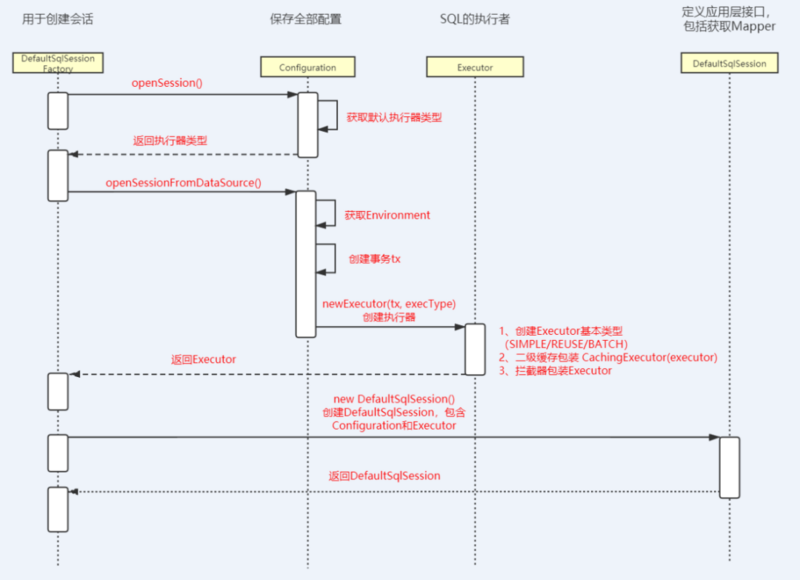关注“Java 后端技术全栈”
回复“面试”获取全套面试资料
老规矩,先上案例代码,我们按照这个案例一步一步的搞定 Mybatis 源码。
public class MybatisApplication { public static final String URL = "jdbc:mysql://localhost:3306/mblog"; public static final String USER = "root"; public static final String PASSWORD = "123456"; public static void main(String[] args) { String resource = "mybatis-config.xml"; InputStream inputStream = null; SqlSession sqlSession = null; try { inputStream = Resources.getResourceAsStream(resource); SqlSessionFactory sqlSessionFactory = new SqlSessionFactoryBuilder().build(inputStream); sqlSession = sqlSessionFactory.openSession(); UserMapper userMapper = sqlSession.getMapper(UserMapper.class); System.out.println(userMapper.selectById(1)); } catch (Exception e) { e.printStackTrace(); } finally { try { inputStream.close(); } catch (IOException e) { e.printStackTrace(); } sqlSession.close(); } }
复制代码
前面我们已经讲了 Mybatis 是如何解析相关配置文件的,如果怕迷路,还是建议先看前一篇文章:
Mybatis是如何解析配置文件的?看完终于明白了
由于很多小伙伴在催,说 Mybatis 源码系列好像何时才有下文了,为此老田熬夜写了这篇。

图片
继续开撸~~
SqlSession sqlSession = sqlSessionFactory.openSession();
复制代码
前面那篇文章已经分析了,这里的 sqlSessionFactory 其实就是 DefaultSqlSessionFactory。
所以这里,我们就从 DefaultSqlSessionFactory 里的 openSession 方法开始。
public class DefaultSqlSessionFactory implements SqlSessionFactory { private final Configuration configuration; public DefaultSqlSessionFactory(Configuration configuration) { this.configuration = configuration; } //创建session,这个方法直接调用本类中的另外一个方法 @Override public SqlSession openSession() { return openSessionFromDataSource(configuration.getDefaultExecutorType(), null, false); } //其实是调用这个方法 private SqlSession openSessionFromDataSource(ExecutorType execType, TransactionIsolationLevel level, boolean autoCommit) { Transaction tx = null; try { //对应xml标签<environments> ,这个在配置文件解析的时候就已经存放到configuration中了。 final Environment environment = configuration.getEnvironment(); final TransactionFactory transactionFactory = getTransactionFactoryFromEnvironment(environment); tx = transactionFactory.newTransaction(environment.getDataSource(), level, autoCommit); //创建一个executor来执行SQL final Executor executor = configuration.newExecutor(tx, execType); //这里也说明了,为什么我们代码里的SqlSession是DefaultSqlSession return new DefaultSqlSession(configuration, executor, autoCommit); } catch (Exception e) { closeTransaction(tx); // may have fetched a connection so lets call close() throw ExceptionFactory.wrapException("Error opening session. Cause: " + e, e); } finally { ErrorContext.instance().reset(); } } private TransactionFactory getTransactionFactoryFromEnvironment(Environment environment) { if (environment == null || environment.getTransactionFactory() == null) { return new ManagedTransactionFactory(); } return environment.getTransactionFactory(); }
复制代码
这个方法中的主要内容有:

图片
下面我们就来逐个攻破。
创建事务 Transaction
事务工厂类型可以配置为 JDBC 类型或者 MANAGED 类型。

图片
❝
JdbcTransactionFactory 生产 JdbcTransaction。
ManagedTransactionFactory 生产 ManagedTransaction。
❞
如果配置的 JDBC,则会使用 Connection 对象的 commit()、rollback()、close()方法来管理事务。
如果我们配置的是 MANAGED,会把事务交给容器来管理,比如 JBOSS,Weblogic。因为我们是本地跑的程序,如果配置成 MANAGED 就会不有任何事务。
但是,如果我们项目中是 Spring 集成 Mybatis,则没有必要配置事务,因为我们会直接在 applicationContext.xml 里配置数据源和事务管理器,从而覆盖 Mybatis 的配置。
创建执行器 Executor
调用 configuration 的newExecutor方法创建 Executor。
final Executor executor = configuration.newExecutor(tx, execType);//Configuration中public Executor newExecutor(Transaction transaction, ExecutorType executorType) { executorType = executorType == null ? defaultExecutorType : executorType; executorType = executorType == null ? ExecutorType.SIMPLE : executorType; Executor executor; //第一步 if (ExecutorType.BATCH == executorType) { executor = new BatchExecutor(this, transaction); } else if (ExecutorType.REUSE == executorType) { executor = new ReuseExecutor(this, transaction); } else { executor = new SimpleExecutor(this, transaction); } //第二步 if (cacheEnabled) { executor = new CachingExecutor(executor); } //第三步 executor = (Executor) interceptorChain.pluginAll(executor); return executor; }
复制代码
此方法分三个步骤。
第一步:创建执行器
Executor 的基本类型有三种:
public enum ExecutorType { SIMPLE, REUSE, BATCH}
复制代码
SIMPLE 为默认类型。
为什么要让抽象类 BaseExecutor 实现 Executor 接口,然后让具体实现类继承抽象类呢?
这就是模板方法模式的实现。
❝
模板方法模式就是定义一个算法骨架,并允许子类为一个或者多个步骤提供实现。模板方法是得子类可以再不改变算法结构的情况下,重新定义算法的某些步骤。
❞
关于模板方法模式推荐阅读:
如何快速掌握模板方法模式
抽象方法是在子类汇总实现的,每种执行器自己实现自己的逻辑,BaseExecutor 最终会调用到具体的子类中。
抽象方法
protected abstract int doUpdate(MappedStatement ms, Object parameter) throws SQLException;protected abstract List<BatchResult> doFlushStatements(boolean isRollback) throws SQLException;protected abstract <E> List<E> doQuery(MappedStatement ms, Object parameter, RowBounds rowBounds, ResultHandler resultHandler, BoundSql boundSql) throws SQLException;protected abstract <E> Cursor<E> doQueryCursor(MappedStatement ms, Object parameter, RowBounds rowBounds, BoundSql boundSql) throws SQLException;
复制代码
第二步:缓存装饰
在上面代码中的第二步
if (cacheEnabled) { executor = new CachingExecutor(executor);}
复制代码
如果cacheEnabled=true,会用装饰器设计模式对 Executor 进行装饰。
第三步:插件代理
缓存装饰完后,就会执行
executor = (Executor) interceptorChain.pluginAll(executor);
复制代码
这里会对 Executor 植入插件逻辑。
比如:分页插件中就需要把插件植入的 Executor

图片
好了,到此,执行器创建的就搞定了。
创建 DefaultSqlSession 对象
把前面解析配置文件创建的 Configuration 对象和创建的执行器 Executor 赋给 DefaultSqlSession 中的属性。
public DefaultSqlSession(Configuration configuration, Executor executor, boolean autoCommit) { this.configuration = configuration; this.executor = executor; this.dirty = false; this.autoCommit = autoCommit;}
复制代码
到这里,SqlSession(DefaultSqlSession)对象就创建完毕。
总结
本文我们讲了如何创建 SqlSession 的几个步骤,最后我们获得一个 DefaultSqlSession 对象,里面包含了执行器 Executor 和配置对象 Configuration。Executor 是 SQL 的实际执行对象。Configuration 里保存着配置文件内容。
本文源码分析的整个流程如下图:

图片
码字不易,给个在看,点个赞呗
推荐阅读
面试官:Mybatis里的设计模式有哪些?我一口气答了8种
面试官问我:能说几个常见的Linux性能调优命令吗?

















评论